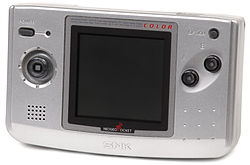- Neo Geo Pocket Color
-
Neo Geo Pocket Color 
Manufacturer SNK Product family Neo Geo Generation Sixth generation era Retail availability - JP March 16, 1999
- NA August 6, 1999
- EU 1999
Introductory price $69.95 Units sold 2 million, including Neo-Geo Pocket units (as of July 30, 2007)[1] Media Cartridge CPU Toshiba TLCS900H core (16-bit) clocked at 6.144MHz, Zilog Z80 clocked at 3.072MHz for sound Memory 12KB RAM for 900H, 4KB RAM for Z80, 64KB ROM Display 160x152 resolution, 146 colors on screen out of a palette of 4096 Backward
compatibilityNeo Geo Pocket Predecessor Neo Geo Pocket The Neo Geo Pocket Color (shortened NGPC), is a 16-bit colour handheld game console by SNK. It was the last console they produced in the Neo Geo family. It was released on March 16, 1999 in Japan, August 6, 1999 in North America, and some time in 1999 in Europe.
The Neo Geo Pocket Color was designed to replace SNK's original Neo Geo Pocket monochrome handheld, which debuted in 1998 in Japan. In 2000, following SNK's purchase by Japanese pachinko manufacturer Aruze, the Neo Geo Pocket Color was dropped from both the North American and European markets. It did, however, last until 2001 in Japan, with a total of 2 million units sold.
Contents
US Release
The NA version of the Neo Geo Pocket Color had an exclusive launch on the website eToys in 1999. eToys also sold the initial launch titles in the preferred plastic snap lock cases. The system debuted in the United States with six launch titles (twenty promised by end of year) and retail price of $69.95. Six different unit colors were available: Camouflage Blue, Carbon Black, Crystal White, Platinum Blue, Platinum Silver, and Stone Blue.
Before SNK was bought out, the Neo Geo Pocket Color was being advertised on US television and units were being sold nationally in Wal-Mart, Best Buy, Toys "R" Us, and other large retail chains.
Post-Aruze buyout
Remaining stock was bought back by SNK for repackaging in Asia. In June 2000, SNK of America (and Europe) tried recalling most of the back-stock of systems and games to be flashed and re-sold in Asia where the system would continue to be sold and supported. Some of the back-stock of NA NGPC hardware and software started showing up back on the marketplace in North America and Asia in 2003. These units frequently appeared bundled with six games stripped of their cases and manuals. Two games often included, Faselei! and Last Blade were never previously released in United States, meaning that they have no US-localized box or manual; however, these titles did receive a European release, incorporating an English translation.
Legacy
The system enjoyed a greater success than any Game Boy competitor since Sega's Game Gear. However, it was hurt by several factors, such as the Neo Geo heads' (the Barone family) notorious lack of communication with third-party developers,[2] the success of the Game Boy Color and the Pokémon franchise, and anticipation of the Game Boy Advance.[citation needed]
Technical specifications
- CPUs: Toshiba TLCS900H core (16-bit), 6.144 MHz, Z80 at 3.072 MHz for sound.
- RAM: 12 k for 900H, 4k for Z80 (shared with the 900H).
- ROM: 64 k boot ROM.
- Interfaces: SIO 1 channel 19200 bit/s, 5-pin serial port.
- Resolution: 160x152 (256x256 virtual screen).
- DMA: 4 channels.
- Colors: 16 palettes per plane, 48 palettes. 146 colors on screen out of 4096 (or 20 colors out of 4096 in monochrome mode).
- Sprites: 64 sprites per frame (8x8), 4 colors per sprite.
- Scrolling: 2 scrolling planes, 8x8 character tiles (characters matrix shared with the sprites), 4 colors per tile.
- Sound: SN76489 variant, T6W28 (3 square wave tone generators with limited stereo capability + 1 monaural noise generator + direct access to the two 6 bits DAC).
- Cartridges: Maximum 4 MB (32 Mbit) with 4 to 16 Mbit flash memory.
- Batteries: 40 hours on 2 AA batteries. Lithium CR2032 battery backs up memory and clock.
The system has an on-board language setting, and games display text in the language selected (provided the cartridge supports that language). Other settings can be set on the handheld such as time and date, and the system can provide customized horoscopes when one's birth-date is entered.
Cables for linking multiple systems were available, as well as a cable to connect the NGPC and the Dreamcast. Games that featured this option include King of Fighters R-2 (links with King of Fighters '99 Dream Match and King of Fighters Evolution), SNK vs Capcom - Match of the Millennium (links with Capcom vs SNK), SNK vs Capcom - Card Fighters' Clash (links with King of Fighters Evolution), SNK vs Capcom - Card Fighters' Clash Expand Edition (links with Capcom vs SNK) and Cool Cool Jam (links with Cool Cool Toon). There was a wireless connector released in Japan that allowed several players in proximity to play together, with some cartridge moulding reshaped to hold it. An MP3 audio player add-on was developed but was not released due to SNK's closure.
See also
References
- ^ Blake Snow (2007-07-30). "The 10 Worst-Selling Handhelds of All Time". GamePro.com. http://www.gamepro.com/gamepro/domestic/games/features/125748.shtml. Retrieved 2008-01-17.
- ^ "NeoGeo Pocket Color Feature". http://www.captainwilliams.co.uk/gaming/ngpc/ngpc.php. Retrieved 2010-10-09.
External links
Handheld game consoles Bandai Entex Game Park/Holdings Nintendo Game & Watch (Mini Classics) · Game Boy (Pocket · Light) · Game Boy Color · Game Boy Advance (SP · Micro · Visteon Dockable Entertainment) · Pokémon mini · Nintendo DS (Lite · DSi · DSi XL) · Nintendo 3DSNokia Sega SNK Neo Geo Pocket · Neo Geo Pocket ColorSony Other handhelds 1970s1980s1990s2000s2010sEarly units · Comparison Categories:- 1998 introductions
- Backward compatible video game consoles
- Handheld game consoles
- Regionless game consoles
- Sixth-generation video game consoles
- Neo Geo Pocket
- SNK Playmore consoles
- Toys of the 1990s
Wikimedia Foundation. 2010.



